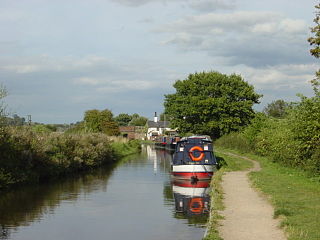
The Trent and Mersey Canal is a 93+1⁄2-mile (150 km) canal in Derbyshire, Staffordshire and Cheshire in north-central England. It is a "narrow canal" for the vast majority of its length, but at the extremities to the east of Burton upon Trent and north of Middlewich, it is a wide canal.
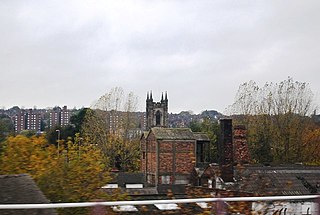
Stoke-on-Trent is a city and unitary authority area in Staffordshire, England, with an area of 36 square miles (93 km2). In 2022, the city had an estimated population of 259,965. It is the largest settlement in Staffordshire and is surrounded by the towns of Newcastle-under-Lyme, Alsager, Kidsgrove and Biddulph, which form a conurbation around the city.

The Etruria Works was a ceramics factory opened by Josiah Wedgwood in 1769 in a district of Stoke-on-Trent, Staffordshire, England, which he named Etruria. The factory ran for 180 years, as part of the wider Wedgwood business.

Denby Pottery Company Ltd is a British manufacturer of pottery, named after the village of Denby in Derbyshire where it is based. It primarily sells hand-crafted stoneware tableware, kitchenware and serveware products including dinner sets, mugs and serving dishes, as well as a variety of glassware products and cast-iron cookware.

The Staffordshire Potteries is the industrial area encompassing the six towns Burslem, Fenton, Hanley, Longton, Tunstall and Stoke in Staffordshire, England. North Staffordshire became a centre of ceramic production in the early 17th century, due to the local availability of clay, salt, lead and coal.

Burslem is one of the six towns that along with Hanley, Tunstall, Fenton, Longton and Stoke-upon-Trent form part of the city of Stoke-on-Trent in Staffordshire, England. It is often referred to as the "mother town" of Stoke on Trent. The population of the town was included under the Burslem Central ward and had a population of 6,490 in the 2021 Census.

Middleport is a residential and industrial district in the city of Stoke-on-Trent, England. Middleport lies to the west of Burslem, between Burslem and the Newcastle-under-Lyme district of Porthill. To the north is Tunstall and to the south Cobridge and Etruria. Middleport conjoins Longport.
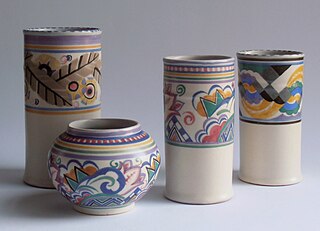
Poole Pottery is a British pottery brand owned by Denby Pottery Company, with the products made in Stoke on Trent, Staffordshire.

Tunstall is one of the six towns that, along with Burslem, Longton, Fenton, Hanley and Stoke-upon-Trent, amalgamated to form the City of Stoke-on-Trent in Staffordshire, England. It was one of the original six towns that federated to form the city. Tunstall is the most northern, and fourth largest town of the Potteries. It is situated in the very northwest of the city borough, with its north and west boundaries being the city limit. It stands on a ridge of land between Fowlea Brook to the west and Scotia Brook to the east, surrounded by old tile-making and brick-making sites, some of which date back to the Middle Ages.

Charlotte Rhead was an English ceramics designer active in the 1920s and the 1930s in the Potteries area of Staffordshire.

Longton is one of the six towns which amalgamated to form the county borough of Stoke-on-Trent in 1910, along with Hanley, Tunstall, Fenton, Burslem and Stoke-upon-Trent in Staffordshire, England.

The Gladstone Pottery Museum is a working museum of a medium-sized coal-fired pottery, typical of those once common in the North Staffordshire area of England from the time of the Industrial Revolution in the 18th century to the mid 20th century. It is a grade II* listed building.

Longport is an area of Stoke-on-Trent, England. It is the location for Longbridge Hayes industrial estate.
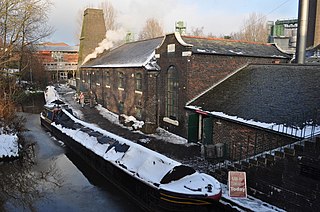
The Etruria Industrial Museum is located in Etruria, Staffordshire, in England. The museum is a typical and well-preserved example of a nineteenth century British steam-powered potter's mill. It is situated between the Trent and Mersey Canal and the Etruria staircase locks of the Caldon Canal. The museum has a modern entrance building, leading into a Grade II* listed building which was formerly the Etruscan bone and flint mill. The mill is also a scheduled monument.
Stoke-on-Trent is a city in Staffordshire, England. Known as The Potteries and is the home of the pottery industry in the United Kingdom. Formed in 1910 from six towns, the city has almost 200 listed buildings within the city. Many of these are connected with the pottery industry and the people involved with it.

A bottle oven or bottle kiln is a type of kiln. The word 'bottle' refers to the shape of the structure and not to the kiln's products, which are usually pottery, not glass.

A.J. Wilkinson was a pottery or potbank at Newport in Burslem, owned by the Shorter family since 1894. A sprawling complex of bottle ovens, kilns and production shops, it lay beside the Trent and Mersey Canal, the artery which provided it with coal and the raw materials for earthenware. In its heyday it employed 400 manual workers.
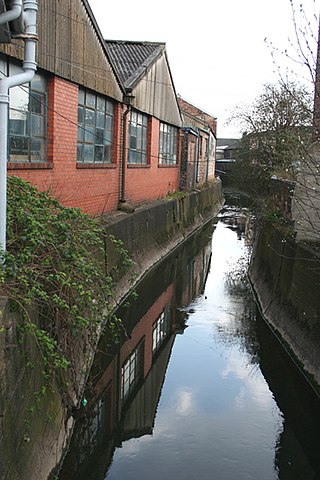
Fowlea Brook rises in Staffordshire and flows through the northern parts of Stoke-on-Trent, England. It is a tributary stream of the River Trent, and is 6 miles (9.7 km) long.

Middleport Pottery was built in 1888 by Burgess & Leigh Ltd. It is located at Middleport, Stoke-on-Trent, England. The buildings, which still house an active pottery, are protected for their historic interest. Middleport Pottery is owned and operated by Re-Form Heritage.
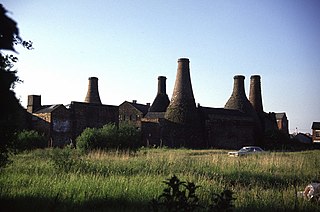
A potbank is a colloquial name for a pottery factory in North Staffordshire used to make bone china, earthenware and sanitaryware.






















